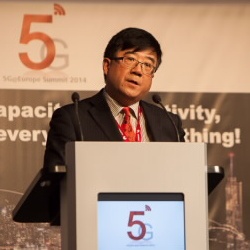  Huawei was the first ICT solutions provider to complete the entire second phase of 5G technology R&D test organized by the IMT-2020 (5G) Promotion Group. The results obtained during the test were showcased at the PT/Expo China 2017.
Huawei's leading position in test completion and newly acquired results further accelerate the progress of 5G technology R&D and help form a set of global unified standards to impressively conclude China's second phase of 5G test.
Huawei achieved the best air interface test result to secure industry-leading dominance. Using 200 MHz bandwidth on the C-band, the downlink cell peak rate exceeded 32 Gbps. Huawei assumed the initiative to integrate all key 5G New Radio (NR) technologies. These include f-OFDM, new frame structure, new codes (such as Polar Code), new parameter sets, Massive MIMO, and SCMA. The overwhelming leadership shown during the second-phase test once again demonstrated Huawei's cutting-edge advantage in technical innovation. This was combined with the successful verification of multiple core technologies based on the results of the first-phase test, which were later incorporated into 3GPP standards.
The 5G-oriented core network and access network were the first to pass verification. During the second-phase test, Huawei was the first to provide end-to-end (E2E) isolated network slices from 5G NR to networks using one set of telecom infrastructure. Network slicing enables ultra-large bandwidth, high reliability, low latency, and massive connections. The test results far exceeded 5G requirements of multiple vertical industries, as defined by the ITU.
At the test location in Huairou District, Beijing, over 100 channels of 4K video were smoothly streamed in vehicle-mounted mobile scenarios, showcasing a superior experience for future C-band eMBB. Huawei recently updated the industry record of 0.3 ms one-way latency over the air interface with reliability of over 99.999% during test scenarios (such as vehicle platooning and emergency braking). For Huawei, this achievement marks a significant breakthrough in remote and autonomous driving, while more importantly helping to realize the advancement of 5G core technologies.
Additionally, Huawei is committed to promoting industry interoperability tests to accelerate the maturity of the 5G ecosystem. During the second-phase test, Huawei was the first to complete the device-pipe interoperability test in partnership with upstream and downstream enterprises, such as NTT DOCOMO and MediaTek. This comprehensively develops capabilities for 5G commercial deployment by 2020.
Huawei is proactively exploring key services during the 5G technology R&D test, which includes partnering with vertical industries to apply 5G to remotely controlled driving of vehicles and drones, holographic calls, smart manufacturing, and other use cases. The second-phase test results of 5G Mobile Edge Computing (MEC) showed that 5G will further help operators enable new smart use cases, such as at a campus, stadium, and office environment.
Wang Zhiqin, Deputy Director of the China Academy of Information and Communications Technology (CAICT) and IMT-2020 (5G) Promotion Group, emphasized that, "Under global unified 5G standards, IMT-2020 (5G) Promotion Group and Huawei are engaging in close collaboration. During the second-phase test, this partnership helps to deliver considerable achievements both in R&D and tests involving the NR and network technology solutions. These tests further contribute to add confidence in promoting the development of 5G technology innovation, while jointly accelerating the formation of unified 5G standards."
Dr. Tong Wen, Huawei Fellow and Wireless CTO, indicated that "During 5G development, Huawei's outstanding performance in leadership has led to a large number of positive influences. For example, not only has Huawei produced industry-leading test results in cell throughput and single terminal data rate, but has also promoted flexibility of 5G standards and established a capable E2E industry chain. With a broad mindset and global vision, Huawei will continue to lead in 5G technology innovation and maintain a competitive edge in 5G standards and architecture, while pursuing the development of cross-industry collaboration. This will speed up the formation of unified 5G standards and create a global ecosystem of coordinated spectrum."
China's 5G technology R&D test procedures first began during 2016 and will continue to the end of 2018. These procedures involve three phases of verification, firstly targeting 5G core technologies, then 5G technology solutions, and finally the entire 5G system. Over the past two years, Huawei has achieved remarkable performance in both first- and second-phase tests, and continued efforts will concentrate on 5G system verification in preparation for commercial 5G deployment by 2020. |